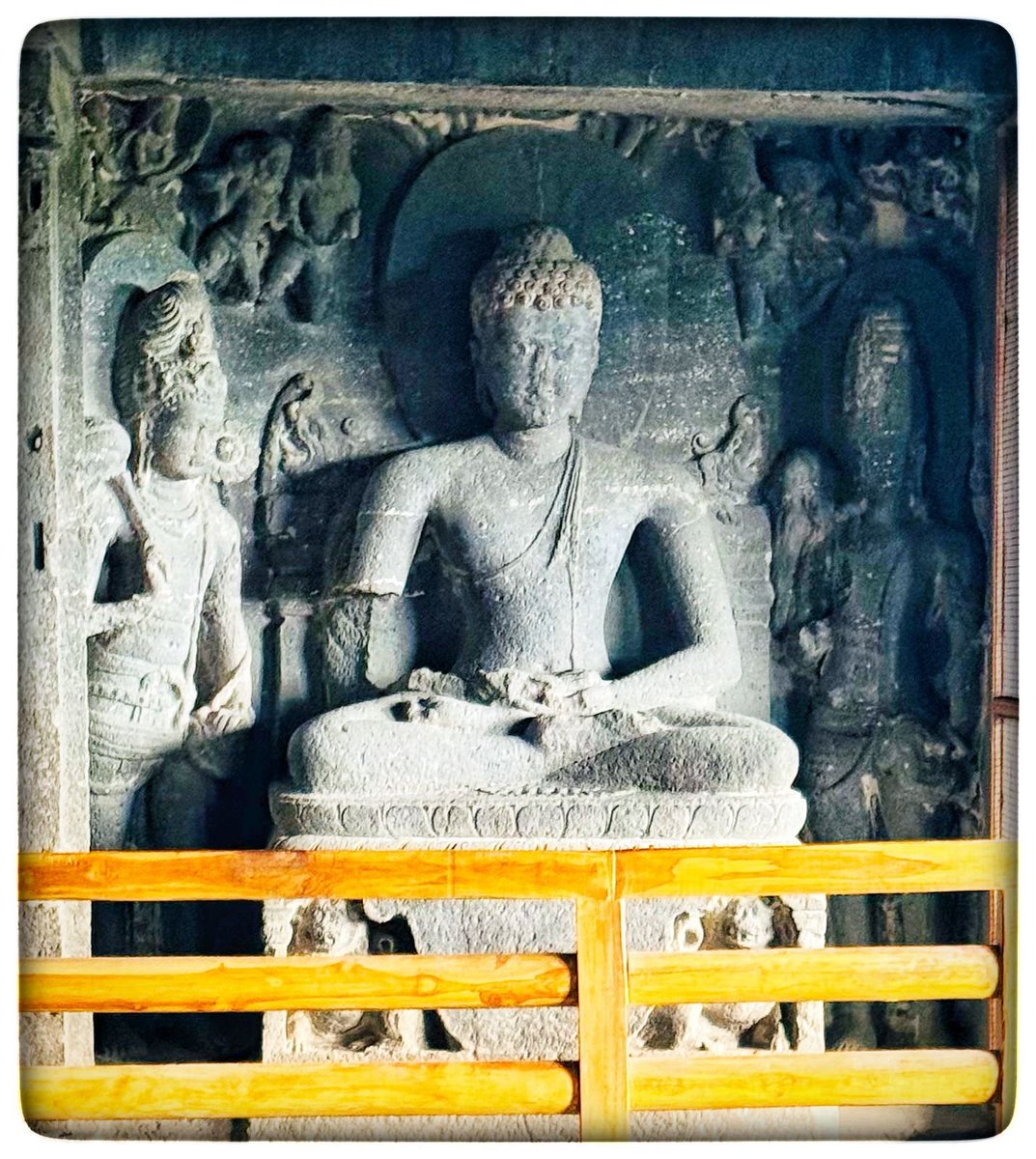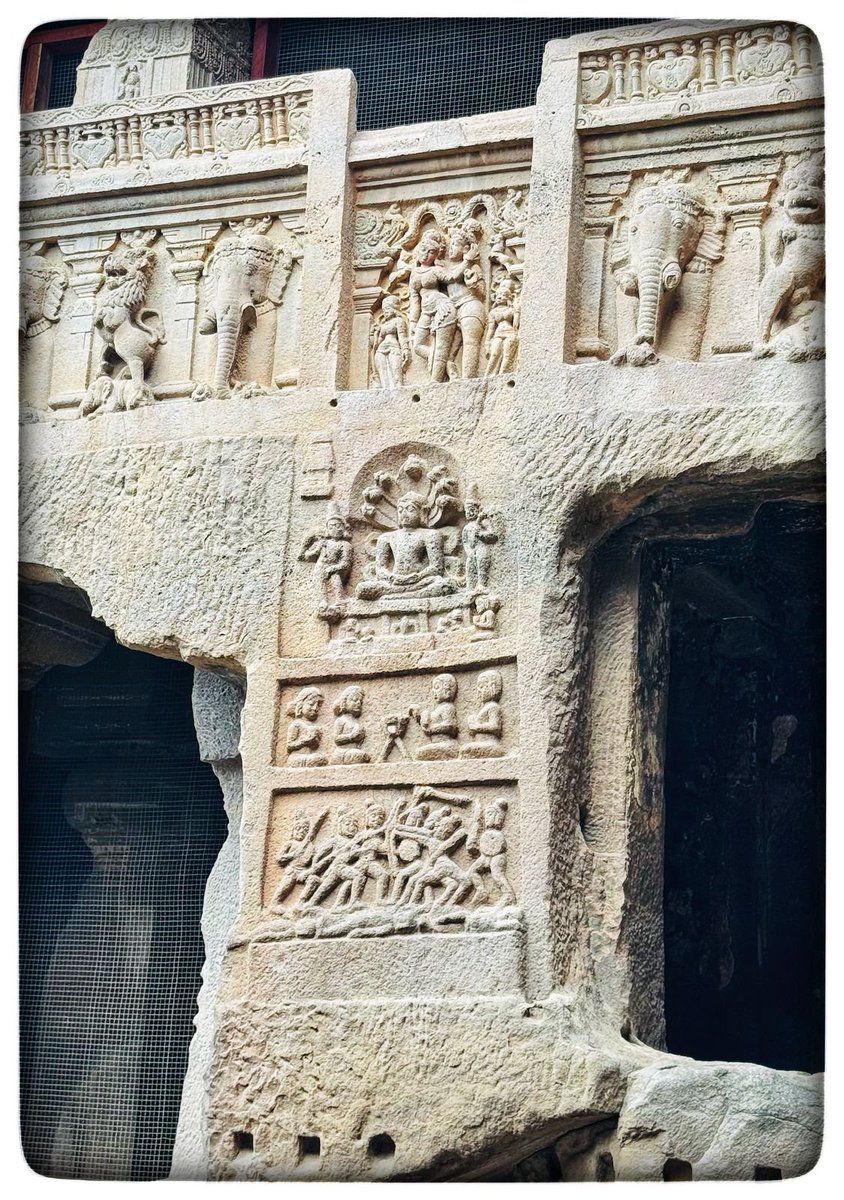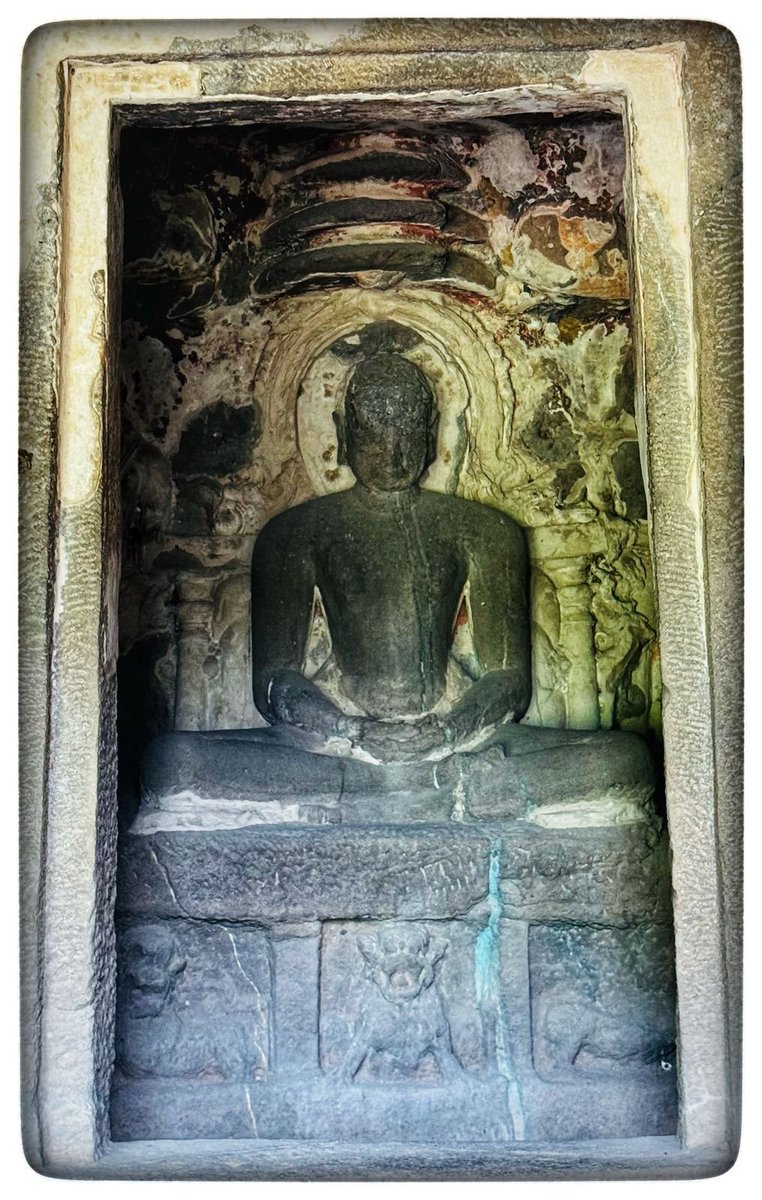#IndianRockCutTemples
1 Ellora – Cave 12 (Buddhist)
#BuddhistCavesOfEllora
📍 Cave 12 – Teen Tal / Teen Taal
This is the only 3-storey Buddhist monastery at Ellora.
Each level was carved out of a single basalt rock, with pillared halls, monk cells, and sanctums.
Not just a cave. This was a vertical university of Dharma.



1 Ellora – Cave 12 (Buddhist)
#BuddhistCavesOfEllora
📍 Cave 12 – Teen Tal / Teen Taal
This is the only 3-storey Buddhist monastery at Ellora.
Each level was carved out of a single basalt rock, with pillared halls, monk cells, and sanctums.
Not just a cave. This was a vertical university of Dharma.




🧘♂️ Main Deity
At the heart: a massive seated Buddha in dhyana mudra (meditation pose).
Celestial beings flank him, often interpreted as Avalokiteshvara (the embodiment of compassion) and Tārā (a saviour goddess).
It marks the Mahayana and early Vajrayana influence.



At the heart: a massive seated Buddha in dhyana mudra (meditation pose).
Celestial beings flank him, often interpreted as Avalokiteshvara (the embodiment of compassion) and Tārā (a saviour goddess).
It marks the Mahayana and early Vajrayana influence.




🔆 Saptabuddhas – The Seven Buddhas of the Past
One of the most iconic features of Cave 12:
Sculptures of the seven past Buddhas before Gautama Buddha:
→ Vipassi
→ Sikhi
→ Vessabhu
→ Kakusandha
→ Konagamana
→ Kassapa
→ Gautama
Here you see them in a preaching position.



One of the most iconic features of Cave 12:
Sculptures of the seven past Buddhas before Gautama Buddha:
→ Vipassi
→ Sikhi
→ Vessabhu
→ Kakusandha
→ Konagamana
→ Kassapa
→ Gautama
Here you see them in a preaching position.




🛕 Three Levels, Three States of Realisation
Scholars suggest symbolic meanings for the 3 floors:
1st: Śīla (discipline)
2nd: Samādhi (meditation)
3rd: Prajñā (wisdom)
As you climb, you rise spiritually, too.
A pilgrimage within the structure.
Scholars suggest symbolic meanings for the 3 floors:
1st: Śīla (discipline)
2nd: Samādhi (meditation)
3rd: Prajñā (wisdom)
As you climb, you rise spiritually, too.
A pilgrimage within the structure.

👸 The Three Goddesses of Cave 12
This isn’t just monk territory — it’s a Shakti Kshetra in disguise.
Tārā – the liberating goddess, often beside Avalokiteshvara, holding a lotus.
Bhrikuti – fierce yet benevolent, defender of Dharma.
Hariti – once a child-eating yakshini, transformed into the goddess of fertility and motherhood. Always shown with children.


This isn’t just monk territory — it’s a Shakti Kshetra in disguise.
Tārā – the liberating goddess, often beside Avalokiteshvara, holding a lotus.
Bhrikuti – fierce yet benevolent, defender of Dharma.
Hariti – once a child-eating yakshini, transformed into the goddess of fertility and motherhood. Always shown with children.



In Ellora Cave 12 (and other Vajrayana Buddhist sites), the depiction of goddesses like Tārā, Bhrikuti, and Hariti wearing a yajnopavīt (sacred thread) may seem surprising at first, because the yajnopavīt is traditionally associated with Brahminical initiation (Upanayana) in Vedic traditions.
In Mahayana and Vajrayana Buddhism, these goddesses aren’t passive consorts — they are active teachers, guides, and protectors on the path to enlightenment.
The sacred thread here becomes a symbol of spiritual authority and initiation, regardless of gender.



In Mahayana and Vajrayana Buddhism, these goddesses aren’t passive consorts — they are active teachers, guides, and protectors on the path to enlightenment.
The sacred thread here becomes a symbol of spiritual authority and initiation, regardless of gender.




In Buddhist tantra, Tārā is not “just a goddess” — she’s a fully awakened being, equal to or even surpassing Avalokiteshvara in salvific power.
The yajnopavīt on her chest sends a clear message:
👉 “Spiritual power is not limited to men.”

The yajnopavīt on her chest sends a clear message:
👉 “Spiritual power is not limited to men.”


Humble, fragmentary inscriptions — mostly on the 2nd floor pillars.
One legible phrase reads: “upāśraya…”, likely part of upāśraya‑dāna, meaning “gift/donation of a shelter (monastery)”.
There’s no royal seal, no conqueror’s name — just quiet acknowledgements.
These inscriptions mark devotional contributions by monks or lay patrons who supported the vihāra.


One legible phrase reads: “upāśraya…”, likely part of upāśraya‑dāna, meaning “gift/donation of a shelter (monastery)”.
There’s no royal seal, no conqueror’s name — just quiet acknowledgements.
These inscriptions mark devotional contributions by monks or lay patrons who supported the vihāra.



Interesting Trivia ::
The cave wasn’t excavated floor-by-floor — all 3 floors were planned simultaneously.
The weight of the upper floors rests precisely over solid stone pillars below.
Inside are sculptures of the Saptabuddhas (7 Buddhas of the Past), each associated with a different Bodhi tree a rare iconographic sequence in Indian caves.
The acoustics inside the main shrine hall are stunning — monks likely used it for chanting and meditation.
Unlike Hindu & Jain caves that show deliberate defacement, Cave 12’s icons are mostly intact.
Why? Possibly because worship had ceased before Islamic invasions, and it was spared.



The cave wasn’t excavated floor-by-floor — all 3 floors were planned simultaneously.
The weight of the upper floors rests precisely over solid stone pillars below.
Inside are sculptures of the Saptabuddhas (7 Buddhas of the Past), each associated with a different Bodhi tree a rare iconographic sequence in Indian caves.
The acoustics inside the main shrine hall are stunning — monks likely used it for chanting and meditation.
Unlike Hindu & Jain caves that show deliberate defacement, Cave 12’s icons are mostly intact.
Why? Possibly because worship had ceased before Islamic invasions, and it was spared.




Though largely Mahayana, Cave 12 hints at early Vajrayana: multi-armed deities, goddesses, and mystical iconography = tantric seeds in stone.
Goddesses like Tārā, Bhrikuti & Hariti are present here all wearing yajnopavīt (sacred thread).
They represent divine feminine authority in Vajrayana thought — not just decoration, but power.
Goddesses like Tārā, Bhrikuti & Hariti are present here all wearing yajnopavīt (sacred thread).
They represent divine feminine authority in Vajrayana thought — not just decoration, but power.

Traces of plaster and pigments were found in some niches, meaning the cave was once vibrantly painted, not bare rock.
You see traces of paint in some of these sculptures.
Cave 12 shows the transition from early Buddhism to Tantric Buddhism — from renunciation to ritual, from solitary monks to cosmic deities.
Two separate staircases connect the floors, not aligned on purpose. This might have been symbolic: not all journeys to higher states are linear.

You see traces of paint in some of these sculptures.
Cave 12 shows the transition from early Buddhism to Tantric Buddhism — from renunciation to ritual, from solitary monks to cosmic deities.
Two separate staircases connect the floors, not aligned on purpose. This might have been symbolic: not all journeys to higher states are linear.


Traces of Ritual Use
Niches in walls suggest lamps, ritual items, and small offerings.
Though the cave today seems monastic, it likely had a functional shrine space, especially on the 3rd floor.
Cave 12 is one of the most spiritually rich and best-preserved Buddhist caves in India.
Niches in walls suggest lamps, ritual items, and small offerings.
Though the cave today seems monastic, it likely had a functional shrine space, especially on the 3rd floor.
Cave 12 is one of the most spiritually rich and best-preserved Buddhist caves in India.
@threadreaderapp unroll
• • •
Missing some Tweet in this thread? You can try to
force a refresh








































